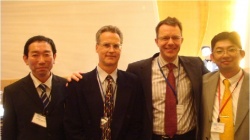Watching the lungs work
Held near Kobe, Japan, the Joint Meeting of the International Workshop and the Japanese Society of Pulmonary Functional Imaging drew in more than 250 international researchers and clinicians who work at the forefront of pulmonary functional imaging


‘The interaction between medical engineering and different specialities from clinical medicine is a major goal for this joint meeting’, said the meeting President Dr Yoshiharu Ohno. Indeed, the participants vividly discussed emerging clinical needs that include functional imaging for a wide variety of lung diseases, as well as the latest technology and software tools provided by medical engineering.
The new developments in pulmonary functional imaging focused on two fields.
(1) 4-D imaging of the lung, particularly using CT. This can be applied to visualise and quantify motion, lung function, tracheomalacia and perfusion. Dual energy CT together with inhalation of Xenon gas enables ventilation assessment. Special care must be taken to minimise radiation exposure, particularly for exciting applications in child patients, e.g. by using low tube voltage and iterative reconstruction, as pointed out by Dr Wolfram Stiller (Heidelberg). Dr Klaus Markstaller (Vienna) speculated that 4-D CT might also fulfil some so far unmet clinical needs in anaesthesiology and intensive care.
(2) MRI of the lung with protons is ready for prime time in the clinical arena. Many interesting applications and features were presented making MRI fast, robust and reproducible for routine clinical use, said Dr Hans-Ulrich Kauczor (Heidelberg), President of the European Society of Thoracic Imaging (ESTI).
Highly encouraging data were also presented for MRI using hyperpolarised gases, such as 3He in asthmatics as well as 129Xe, as the less costly alternative with comparable results as summarised by Dr Mark Schiebler, organiser of the 2013 International Workshop in Pulmonary Functional Imaging (IWPFI) in the USA. Before this, many of these exciting topics will be presented and discussed during the joint ESTI/Fleischner meeting (23-25 June 2011. Heidelberg).
Radiology will play a pivotal role in developing and launching new diagnostic tools and techniques in cooperation with engineering, as well as respiratory and nuclear medicine to improve functional and molecular lung imaging further. To this end, this high-level international and interdisciplinary conference took another step towards Watching the lungs work!
02.03.2011










